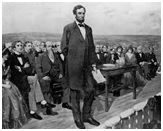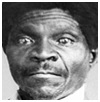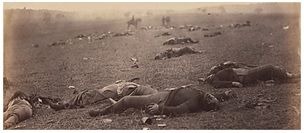|
 |
|
 |
|
|
||
The Battle of Gettysburg - Leadership and Strategy
The Battle of Gettysburg (1863)
Famous for...
1. Union victory A vital victory for the North (the Union side led by President Abraham Lincoln) on 1-3 July 1863 in the American Civil War.
2. The Gettysburg Address President Lincoln’s speech after the battle on 19th November (pictured right).
Why is the Gettysburg Address famous?
a) brevity
b) brilliance It emphasized everyone’s right to:
Where did the battle happen? Near the town of Gettysburg in southern Pennsylvania, USA. The winners The Union army (led by General George Meade), pictured right), fighting for:
The losers The Confederate army (led by General Robert E. Lee, pictured right in 1863) They were fighting for the pro-slavery Confederacy (eleven breakaway southern states, led by its president, Jefferson Davis)
Why was slavery the big issue? People in the northern states like William Lloyd Garrison (pictured right) thought that slavery was evil and wanted it abolished (so they were called abolitionists). But the southern states wanted slaves for their cotton plantations which made the landowners extremely rich (like Scarlett O’Hara’s family in the film and book, Gone with the Wind) The South sold:
Key events before the battle
1850 The Fugitive Slave Act This allowed slave owners to recover their slaves in the northern states where slavery was illegal. This was vital to the story of Harriet Beecher Stowe’s (pictured right) Uncle Tom’s Cabin, published in 1852. This best selling anti-slavery novel
A quarter of slave families were broken up.
1857 Dred Scott case Scott (pictured right), a slave, lived in the free northern states for several years. Northern people there were furious at the American Supreme Court’s decision not to give him his freedom. This led to Abraham Lincoln’s famous statement in 1858: “A house divided against itself cannot stand. I believe this government cannot endure, permanently half slave and half free”.
1859 John Brown’s hanging Brown (pictured right), an abolitionist, became a martyr in the north after his unsuccessful raid in Harper’s Ferry, Virginia, which attempted to start a slave rebellion. The tune, John Brown’s Body, became a famous Union marching song in the American Civil War.
1860 Anti-slavery Abraham Lincoln elected as the American president Lincoln (pictured right in 1863) tried to avoid war with the southern states by:
1861, April 12th ,the American Civil War begins The war is triggered by the Confederate government capture of Fort Sumter, South Carolina, on the same day. Lincoln reluctantly goes to war to preserve the Union of all American states.
1861, July 21st., the 1st Battle of Bull Run The Confederate army's first victory is won by:
Other decisive Confederate victories occur at the:
1862 Two Union victories at the battles of Shiloh and Antietam.
1863 On January 1st Abraham Lincoln makes the Emancipation Proclamation, declaring that all slaves are “forever free”.
Key people at Gettysburg
American president.
Leader of the Confederate army.
George Meade Leader of the Union army.
What happened at the Battle of Gettysburg
July 1st Successful Confederate attack on the west and north of the town of Gettysburg. The Union troops retreat but:
Union heroes include:
July 2nd At 4 pm the Confederates (led by General James Longstreet) attack the Union left and right flanks. The Union troops:
July 3rd The Confederates again fail to take Culp’s Hill after six hours of intense
fighting. At 3 pm Lee orders an attack by General George Pickett’s (pictured right) 12,000 troops on the Union centre (now known as Pickett’s Charge). They are beaten back after heavy losses. Lee orders a retreat over the Potomac River into Virginia.
July 4th Lee's retreating army is delayed by rain. But, much to Lincoln's disgust Meade (the Union army’s leader) didn't counter-attack and destroy them - why?
Why the Confederates lost the battle
1. Lee’s leadership Pickett’s Charge was a huge mistake and opposed by his best deputy, General James Longstreet It was particularly dangerous because of the long range accuracy of the Union side’s Minié ball rifle (named after its inventor the Frenchman, Claude Minié, pictured right). Lee's decisive victory at Chancellorsville two months earlier fatally gave him an arrogant sense of invincibility. His judgement was also weakened by diarrhoea.
2. Delay Longstreet's (pictured right) Confederate attack was delayed until 4 pm on July 2nd (partly caused by his intense criticism of Lee's decision to attack). This allowed the Union side to
3. Thomas (“Stonewall”) Jackson’s death Lee lost his brilliant deputy at the Battle of Chancellorsville in May, 1863.
4. Meade’s leadership George Meade:
This success was particularly remarkable because he had only replaced Joseph Hooker, pictured right, as the army chief a few days before. Meade was unfairly criticized by Lincoln for not counter-attacking after Pickett’s Charge - why?
5. The Confederate army was smaller There were around 75,000 Confederate troops against a Union army of 90,000.
5. Hunger Lee’s army was:
Results of the battle
1. Colossal casualties 23,000 Unionists and 28,000 Confederates (more than a third of Lee's army) killed and wounded. 7,000 Confederate wounded left on the battlefield and treated by Union surgeons and volunteer nurses. 620,000 soldiers died during the whole war, two thirds of them from disease (particularly diarrhoea and dysentery). Some of the dead are shown below in Timothy O’Sullivan's famous photograph of the battle, A Harvest of Death.
2.Terror Many soldiers were so tired and terrified that they didn’t fire a single shot (27,514 loaded rifles were found after the battle).
3. Union victory in the war The Gettysburg victory and (more importantly) the capture of Vicksburg by General Ulysses Grant’s (pictured right) army on July 4th were big contributors to the Union victory in the Civil War, which:
. Key post-battle events
July 4th 1863 Capture of Vicksburg by Grant’s Union army.
July 22nd 1864 Atlanta captured by General William Sherman’s (pictured right) Union army.
November 15th 1864 Sherman’s army begins its destructive ‘March to the Sea’, destroying Georgia.
January 31st 1865 Congress abolishes slavery.
March 4th 1865 Lincoln’s Second Inaugural Address after his re-election as president in 1864. His message is conciliatory: “With malice toward none, with charity for all”.
April 9th 1865 Lee surrenders, ending the war.
April 15th 1865 Lincoln is assassinated in a theatre by the Confederate actor, John Wilkes Booth (pictured right).
Why did the North win the Civil War?
1. Leadership Lincoln was a far better leader than the Confederate president, Jefferson Davis (pictured right in 1853), who wasn’t so good at uniting and inspiring his people. The determined leadership of the Union generals, Grant and Sherman, also helped. The Confederate generals, Lee and Jackson, had some brilliant early successes, although Lee’s obsession with attack was sometimes costly (as at Gettysburg), but it was the only viable option. Lee knew that a quick Confederate victory was vital because of the North’s:
2. Machinery and manpower The North had:
3. Logistics The North managed to keep its armies supplied with enough food, water, horses and weapons. This was helped by:
In contrast, Lee’s army was short of food from March 1863 onwards.
4. African Americans Lincoln’s Emancipation Proclamation which freed southern slaves had a big effect. African Americans:
But racial prejudice and segregation still persisted in the South until challenged by the civil rights movement in the 1950's and 1960's, led by Martin Luther King (pictured right).
Key quotes
All this has been my fault, - Robert E. Lee (after the disastrous Pickett’s Charge).
Four score and seven years ago [1776, the American Declaration of Independence] our fathers brought forth on this continent a new nation, conceived in liberty, and dedicated to the proposition that all men are created equal, - Abraham Lincoln (the opening sentence of his Gettysburg Address).
War is cruelty. - General William Sherman.
Be not dishearten’d - Affection shall solve the problems of freedom yet. - Walt Whitman, pictured right, (from a poem in Leaves of Grass)
Best books
Hugh Bicheno, Gettysburg (2001) - on the battle.
James McPherson, Battle Cry of Freedom (1988) - on the American Civil War. |
|
|
||
|
|
||
| Copyright © wisdomtowin.com 2025 All Rights Reserved | ||
|

























